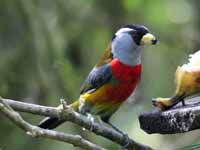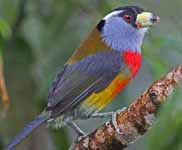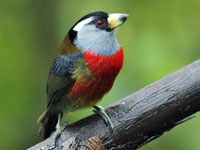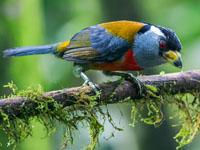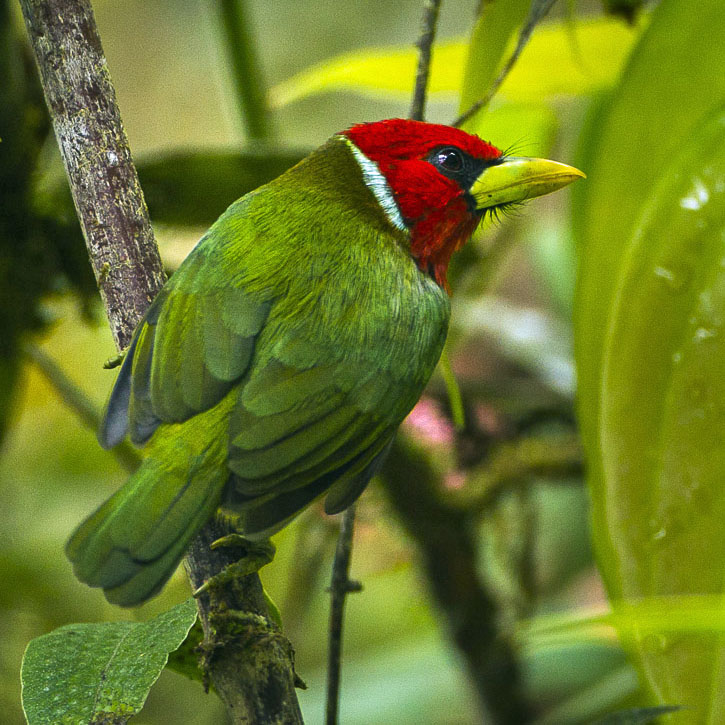The order Piciformes is made up of the woodpecker family Picidae plus 8 other families. Picidae make up about half of the species. In general, the Piciformes are insectivorous, but some exceptions eat mostly fruit. Nearly all Piciformes have parrot-like feet—two toes forward and two back, an arrangement that has obvious advantages for birds that spend much of their time on tree trunks. And most Piciformes do not have down feathers at any age, only true feathers. All nest in cavites.
Family Capitonidae: New World Barbets
There are three barbet families: Capitonidae (New World), Lybiidae (African), and Megalaimidae (Asian). This article describes the New World barbets.
American barbets inhabit tropical forests in Central and South America. They get their name from the bristles which fringe their heavy bills. They are closely related to the toucan and are quite similar to the African barbets which also belong to Piciformes. The American barbets are plump birds, with short necks and large heads, and 15 to 20 cm long. Most species are brightly colored. and inhabit forests. Their diet is similar to African barbets: fruit, seeds and insects. Fruit is eaten whole and indigestible material such as seed pits regurgitated later. These birds do not migrate. They nest in tree holes dug by breeding pairs. Many of these species have declining populations because of habitat loss.
Genus Capito
These 11 Capito barbet species are found in South America with a single species extending into Panama. Males and females are different in appearance. Males have at least some black on their backs. They are primarily fruit and berry eaters, but also eat seeds, insects, and other arthropods. The Captio barbets nest in tree cavities, as do other Capitonidae barbets. They are 16 to 20 cm long.
Barbet,_Black-girdled Capito dayi
Description: The black-girdled barbet has mainly black upperparts with some white (or yellow) patches. The tail is also mainly black with a white patch near the base. The underparts are white or off-white on the upper breast merging to pale greenish yellow on the belly. The black of its flanks merges with a black girdle.The male has a scarlet crown and nape while for the female they are black. Their chin and throat are various shades of brown. The black-girdled barbet is about 17 cm long.
Range: Bolivia, Brazil.
Habitat: Canopy of evergreen primary or secondary forests.
Diet: Fruit and arthropods.
Conservation status: It is listed as Vulnerable because the mature forests it prefers are being destroyed.
Image by: 1) Hector_Bottai - Brazil 2) Jorge Montejo - Brazil 2) Amy McAndrews - Brazil 3) Nick Athanas - BrazilRange: Bolivia, Brazil.
Habitat: Canopy of evergreen primary or secondary forests.
Diet: Fruit and arthropods.
Conservation status: It is listed as Vulnerable because the mature forests it prefers are being destroyed.
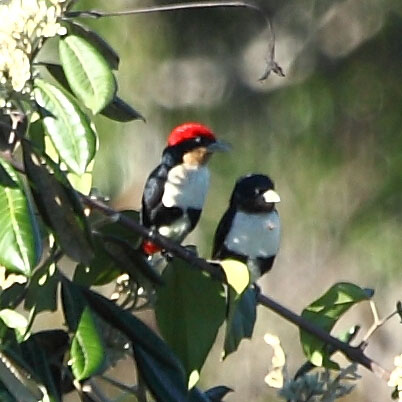
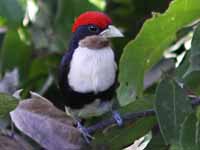
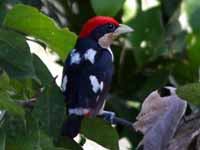
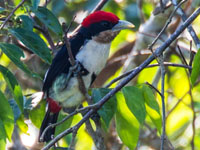
Barbet,_Black-spotted Capito niger
Description: The black-spotted barbet has a red forehead and throat. There ia a yellowish-white supercilium extending down the back. The male has black upperparts, bill, tail, and face. It has a yellowish-white wingbar and underparts, The flanks are black-spotted. The female has black upperparts with light edging, She has yellowish-white underparts with dark stripes on the breast and flanks. The similar gilded barbet has no supercilium.
Range: Northeast Brazil, the Guianas, and Venezuela.
Habitat: Forests, forest edges and more open terrain such as gardens.
Diet: Fruit and arthropods.
Conservation status: It is listed as Near Threatened because the population is suspected to be in decline due to the loss and degradation of habitat.
Image by: 1, 3) Hector_Bottai - Brazil 2, 4) Peter Bono - BrazilRange: Northeast Brazil, the Guianas, and Venezuela.
Habitat: Forests, forest edges and more open terrain such as gardens.
Diet: Fruit and arthropods.
Conservation status: It is listed as Near Threatened because the population is suspected to be in decline due to the loss and degradation of habitat.
1, 2) Female 3, 4) Male
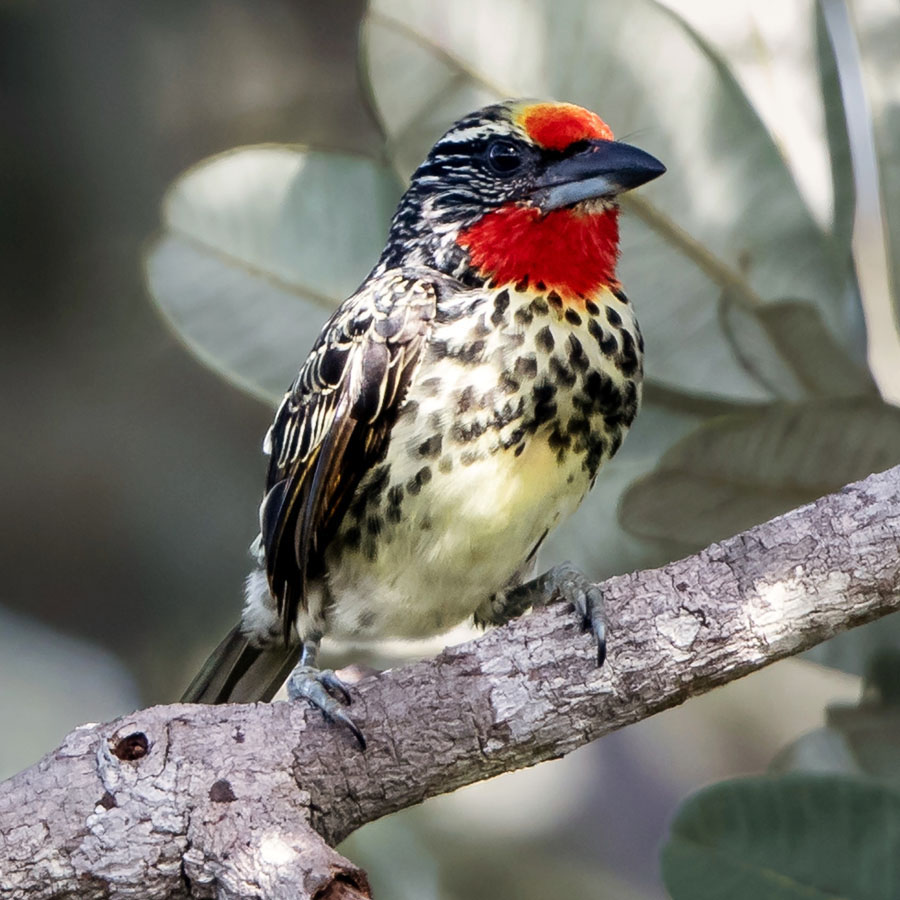
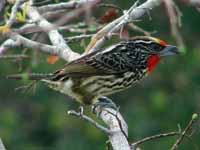
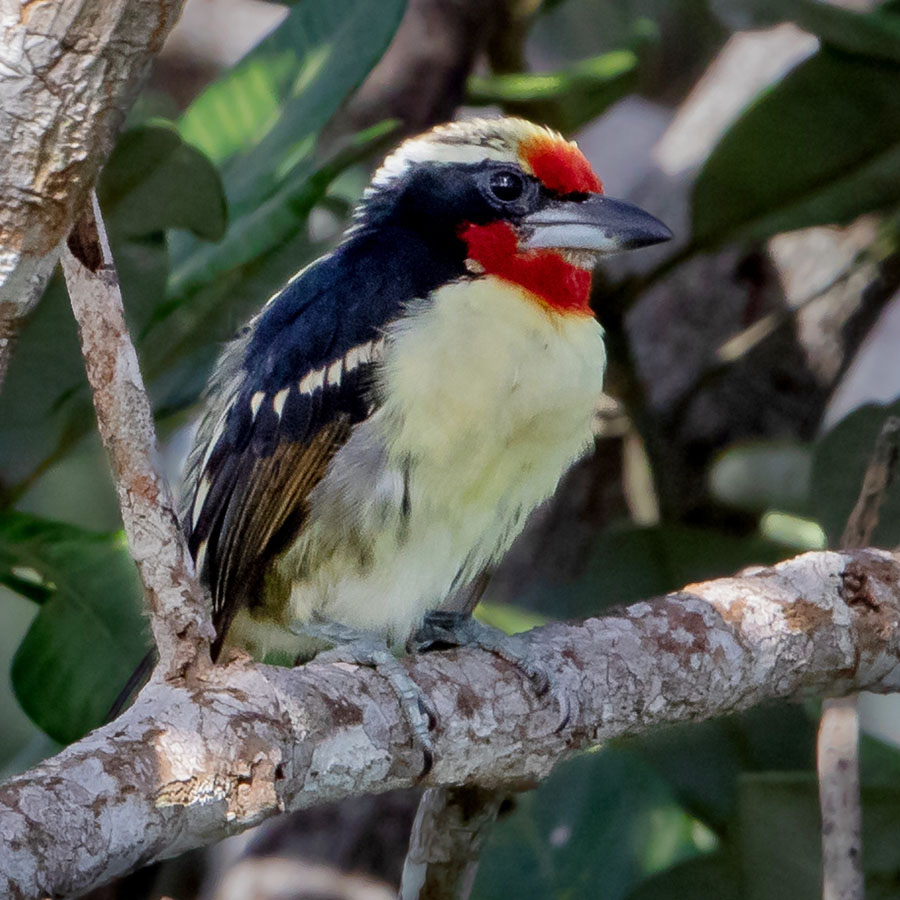
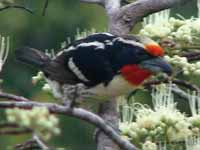
Barbet,_Brown-chested Capito brunneipectus
Description: The brown-chested barbet has black upperparts with yellow streaks. a dull gold crown, black eye-patch, and brown breast-band. The similar female has a pale cinnamon throat with black freckles. The brown-chested barbet is about 18 cm long.
Range: Central Amazon Basin region of Brazil.
Habitat: Canopy of moist forests.
Diet: Fruit, insects, and arthropods.
Conservation status: Least Concern.
Range: Central Amazon Basin region of Brazil.
Habitat: Canopy of moist forests.
Diet: Fruit, insects, and arthropods.
Conservation status: Least Concern.
Barbet,_Five-colored Capito quinticolor
Description: The male five-colored barbet has mainly black upperparts with yellow wingbars and a yellow V on the mantle. His crown and nape are red. The throat and upper-breast are white while the rest of the underparts are yellow and there are black spots on the flanks. The female has yellow streaks on her upperparts and more black spots on her underparts. The five-colored barbet is 17 to 18 cm long.
Range: Columbia. Ecuador.
Habitat: Forests and their edges; also disturbed forest.
Diet: Mainly fruit; also insects.
Conservation status: It is listed as Near Threatened because the population ss suspected to be in decline due to the loss and degradation of habitat.
Image by:
1) J Huet 2, 3) Nick Athanas - EcuadorRange: Columbia. Ecuador.
Habitat: Forests and their edges; also disturbed forest.
Diet: Mainly fruit; also insects.
Conservation status: It is listed as Near Threatened because the population ss suspected to be in decline due to the loss and degradation of habitat.
2, 3) Male



Barbet,_Gilded Capito auratus
Description: The male gilded barbet has black upperparts with a yellowish-white wingbar. It also has a black face. He has a yellow crown, throat, and underparts with black streaks on the flanks. The female has more heavily streaked underparts and more yellow on the upperparts. The gilded barbet is about 20 cm long.The similar black-spotted barbet has a light supercilium that extends down the back.
Range: South America.
Habitat: Lowland forests, forest edges and clearings, along rivers,
Diet: Mainly fruit, also insects.
Conservation status: Least Concern.
Image by: 1, 5) Nick Athanas- Ecuador 2, 4) Patty McGann 3) Tony Castro - Ecuador Range: South America.
Habitat: Lowland forests, forest edges and clearings, along rivers,
Diet: Mainly fruit, also insects.
Conservation status: Least Concern.
1) Pair 2, 3) Female 4, 5) Male
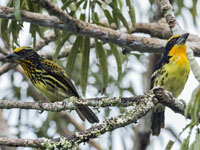
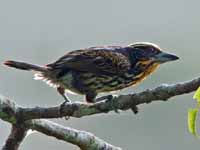
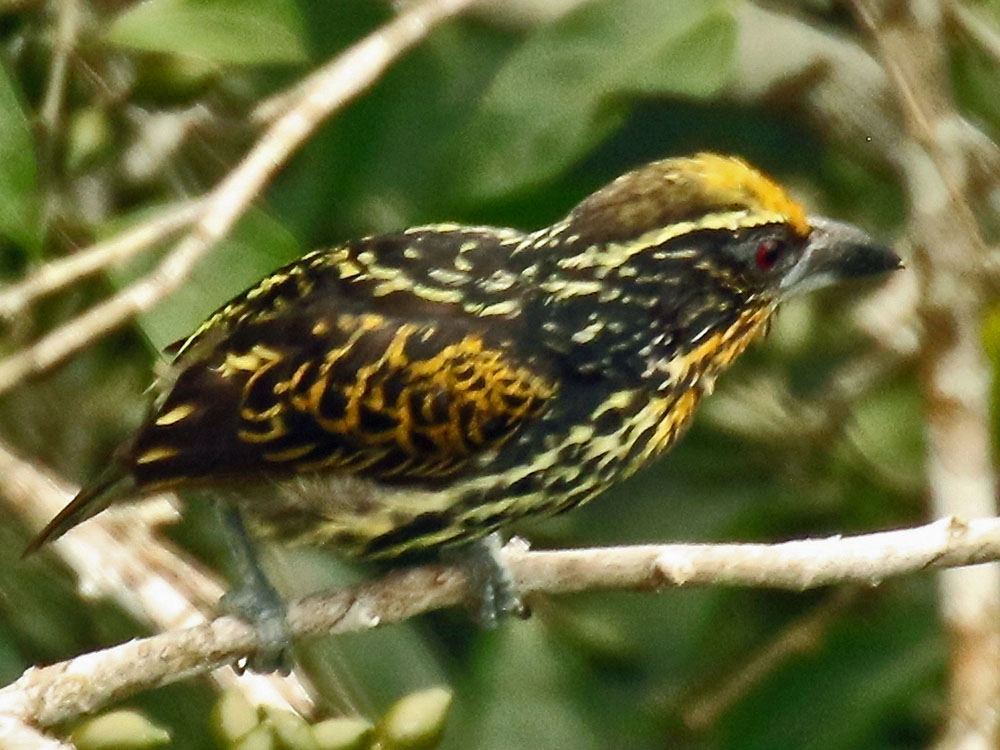
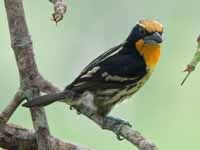
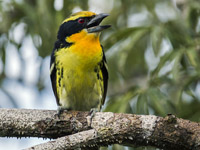
Barbet,_Orange-fronted Capito squamatus
Description: The orange-fronted barbet has black upperparts, mask, and tail. It has an orange forehead plus a white crown and nape. The male has white underparts with yellow wash on breast. The female has a black throat, white edges on the black mantle feathers, a black breast, and white belly. The orange-fronted barbet is 16 to 18 cm long.
Range: Ecuador, Columbia.
Habitat: Forests and their edges, more open areas with trees available.
Diet: Fruits, insects, spiders.
Conservation status: Least Concern.
Image by: 1, 2) Nick Athanas - Ecuadro Range: Ecuador, Columbia.
Habitat: Forests and their edges, more open areas with trees available.
Diet: Fruits, insects, spiders.
Conservation status: Least Concern.
1) Female 2) Female
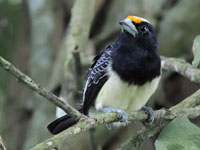
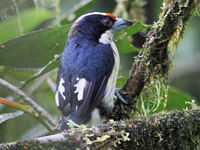
Barbet,_Scarlet-banded Capito wallacei
Description: The scarlet-banded barbet has mainly black upperparts including a black mask. It has a scarlet crown, mantle, and breast band. There is a prominent white supercilium and a white throat.The lower-breast and belly are yellow. The female has a yellow shoulder stripe, the male does not. The scarlet-banded barbet is about 19 cm long.
Range: Peru.
Habitat: Montane forests mainly between 1300 and 1500 meters.
Diet: Fruits, seeds, insects.
Conservation status: It is listed as Vulnerable because the population is probably less than 1000.
Image by: 1) Gossipguy - femaleRange: Peru.
Habitat: Montane forests mainly between 1300 and 1500 meters.
Diet: Fruits, seeds, insects.
Conservation status: It is listed as Vulnerable because the population is probably less than 1000.
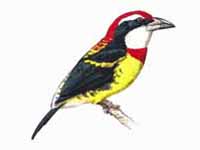
Barbet,_Scarlet-crowned Capito aurovirens Found: South America
Description: The scarlet-crowned barbet has olive upperparts. The male hasa red crown and nape while the female has a whilte crown transitioning to olive on the nape. They have an orange breast becoming olive on the belly. The scarlet-crowned barbet is about 19 cm long and weighs 45 to 75 grams.
Range: Brazil, Colombia, Ecuador, and Peru.
Habitat: Primary and secondary forests, preferring to be near water.
Diet: Mainly fruit and berries; also insects.
Conservation status: Least Concern.
Image by: 1, 2) Claudio Timm - Brazil 3) Nick Athanas - EcuadorRange: Brazil, Colombia, Ecuador, and Peru.
Habitat: Primary and secondary forests, preferring to be near water.
Diet: Mainly fruit and berries; also insects.
Conservation status: Least Concern.
1) Female 2, 3) Male
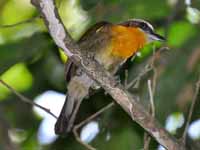
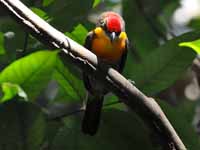
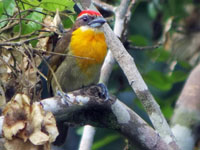
Barbet,_Sira Capito fitzpatricki Found: Peru
Description: The Siri barbet has mainly black upperparts including a black mask. It has a scarlet crown and wide scarlet breast band. There is a prominent white supercilium and a white throat. The lower-breast and belly are whitish. The female hasa yellow shoulder stripe, the male does not. It is about 20 cm long. The Siri barbet has a deeper red and wider breast band than the similar scarlet-banded barbet. Some sources list the Sira barbet as a subspecies of the scarlet-banded.
Range: Cerros del Sira of east-central Peru.
Habitat: Mainly in forests of tall trees.
Diet: Mainly fruits, also insects.
Conservation status: It is listed as Near Threatened because of a very small range and an unknown population size.
Image by: 1) GirlScientistRange: Cerros del Sira of east-central Peru.
Habitat: Mainly in forests of tall trees.
Diet: Mainly fruits, also insects.
Conservation status: It is listed as Near Threatened because of a very small range and an unknown population size.
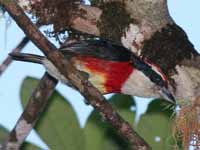
Barbet,_Spot-crowned Capito maculicoronatus
Description: The male spot-crowned barbet has black upperparts. The crown is whitish with some black spots. It has a white throat and upper-breast and a yellowish lower-breast. The belly is mainly white and the flanks are also white with black stripes (and orange in Panama range), grey bill. The female is similar with a black throat and breast. The spot-crowned barbet is 16 to 18 cm long.
Range: Columbia, Panama.
Habitat: Primary and secondary forests.
Diet: Fruits, berries, and insects.
Conservation status: Least Concern.
Image by: 1) Patty McGann 2, 3, 4) Nick Athanas - Panama, Panama, ColumbiaRange: Columbia, Panama.
Habitat: Primary and secondary forests.
Diet: Fruits, berries, and insects.
Conservation status: Least Concern.
1, 2) Pair 3) Female 4) Male
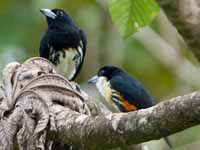
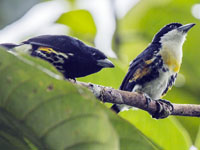

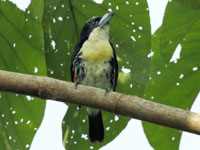
Barbet,_White-mantled Capito hypoleucus
Description: The white-mantled barbet has blue-black upperparts with a white mantle and nape, It has a mainly black head, red forehead and red fore-crown. The underparts are white. and the bill is pale yellow. The female has a black spot next to her bill. The white-mantled barbet is 18 to 19 cm long.
Range: Columbia.
Habitat: Tropical forests, open land with some trees around, orchards.
Diet: Fruits, berries, and also insects.
Conservation status: It is listed as Vulnerable because much of its habitat has been destroyed via cultivation and excessive use of pesticide.
Image by: 1) Columbia Travel 2) Dave Curtis 3) Nick Athanas - ColumbiaRange: Columbia.
Habitat: Tropical forests, open land with some trees around, orchards.
Diet: Fruits, berries, and also insects.
Conservation status: It is listed as Vulnerable because much of its habitat has been destroyed via cultivation and excessive use of pesticide.
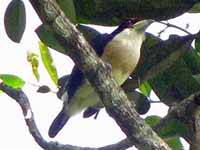
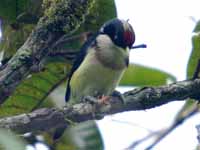
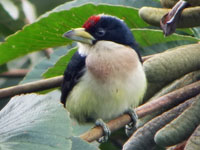
Genus Eubucco
These four American barbets have stubby yellow bills, green backs, yellow on some of the underparts (especially the breast), and, at least in the males, red on the head. They eat mainly fruits, seeds, insects, and other arthropods. The known nest sites that have been found have mainly been in tree cavities, also infrequently in fences posts. The Eubucco barbets are 15 to 17 cm long, slightly smaller than the members of genus Capito,
Barbet,_Lemon-throated Eubucco richardsoni
Description: The male lemon-throated barbet has green upperparts. It has yellow bill, red crown, grey-blue nape, black face, and black chin spot. The throat is yellow as is the upper-breast. There is a reddish transition area between breast and belly, and a pale yellow belly with green stripes. The female has a green crown, black mask, grey bill, grey throat, yellowish upper-breast, and yellow belly with green stripes. The lemon-throated barbet is 15 to 16 cm long and 25 to 35 grams.
Range: Bolivia, Brazil, Colombia, Ecuador, and Peru.
Habitat: Forests, their edges, and clearings.
Diet: Fruits, insects.
Conservation status: Least Concern.
Image by: 1, 2) Nick Athanas - Ecuador 3) Gary_ClarkRange: Bolivia, Brazil, Colombia, Ecuador, and Peru.
Habitat: Forests, their edges, and clearings.
Diet: Fruits, insects.
Conservation status: Least Concern.
1) Female 2, 3) Male
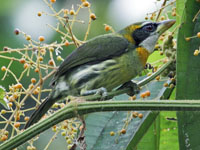
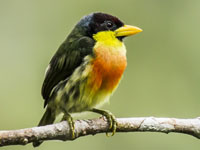
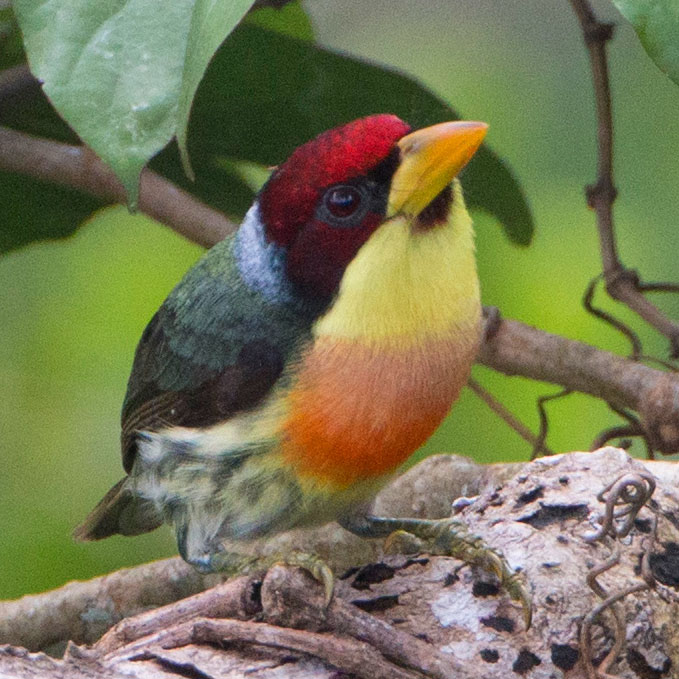
Barbet,_Red-headed Eubucco bourcierii
Description: The red-headed barbet has green upperparts, an orange-yellow breast, and a white belly. The male has a
has a red head, black lores, red bib. and white rear collar. The female's crown and nape vary from dull orange to shades of green among the subspecies. She has a light blue face patch and a black mask. The red-headed barbet is 16 cm long. The similar male versicolored barbet does not have a red bib while the female does not have a black mask.
Range: Costa Rica, Panama, western Venezuela, Colombia, Ecuador and far northern Peru.
Habitat: Forest and forest boundaries.
Diet: Fruits, berries, insects.
Conservation status: Least Concern.
Image by: 1) José Loaiza -
Ecuador 2, 3) Nick Athanas - Ecuador 4) Andy_Morffew - EcuadorRange: Costa Rica, Panama, western Venezuela, Colombia, Ecuador and far northern Peru.
Habitat: Forest and forest boundaries.
Diet: Fruits, berries, insects.
Conservation status: Least Concern.
1, 2) Female 3, 4) Male
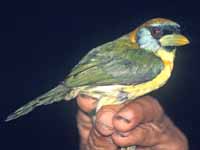
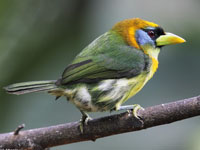
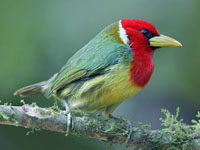
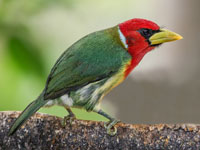
Barbet,_Scarlet-hooded Eubucco tucinkae Found: South America
Description: The male scarlet-hooded barbet has a red hood and mantle. The rest of the upperparts are green. The lower breast and belly are yellow, but the flanks have some green streaks. The female is similar with a yellow instead of a red throat. They have a yellow bill. The scarlet-hooded barbet is 17 cm long.
Range: Bolivia, Brazil, Peru.
Habitat: Mainly bamboo and usually found close to water. Also gardens.
Diet: Fruits, seed, insects, and numerous other arthropods. Also flowers and nectar.
Conservation status: Least Concern.
Image by: 1) Claudio Timm Range: Bolivia, Brazil, Peru.
Habitat: Mainly bamboo and usually found close to water. Also gardens.
Diet: Fruits, seed, insects, and numerous other arthropods. Also flowers and nectar.
Conservation status: Least Concern.
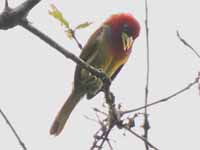
Barbet,_Versicolored Eubucco versicolor
Description: The male versicolored barbet has a red crown, chin, and breast band. It has a blue rear neck collar, yellow breast, and striped belly. Males have much geographical plumage variation. The female has a blue face, blue throat, and red breast band. The versicolored barbet is 16 cm long. The similar male red-headed barbet has a red bib and the female has a black mask.
Range: Peru, Bolivia.
Habitat: Humid forests, mainly from 1000 to 2000 meters.
Diet: Mainly fruits and seeds. Also insects and other arthropods.
Conservation status: Least Concern.
Image by: 1) Robert Lewis 2) Jorge Montejo - Peru 3) James St. John 4) Nick Athanas - Peru Joao_Quental - PeruRange: Peru, Bolivia.
Habitat: Humid forests, mainly from 1000 to 2000 meters.
Diet: Mainly fruits and seeds. Also insects and other arthropods.
Conservation status: Least Concern.
1, 2) Female 3, 4) Male
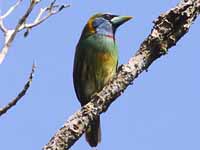
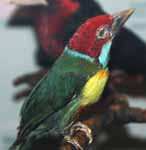
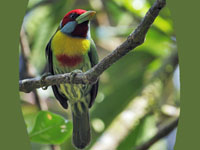
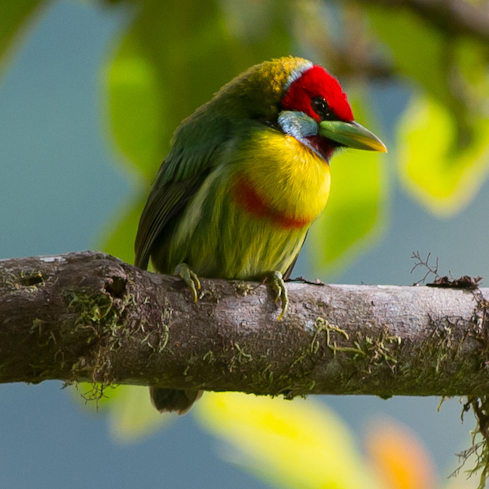
Family Semnornithidae
The toucan-barbets family has only 1 genus and two species. They are between barbet and toucans in appearance. The diet is closer to toucans, but their bills are much smaller than a toucan bill and more like that of a barbet.
Genus Semnornis
Barbet,_Prong-billed Semnornis frantzii
Description: The Prong-billed barbet has brown upperparts. The crown and underparts are orange-brown with blue flanks. It thick grey bill which short thin prong., orange-brown breast. The Prong-billed barbet is 18 cm long. It excavates a nest cavity in a tree and is not a communal breeder.
Range: Costa Rica, western Panama.
Habitat: Highland forests.
Diet: Mainly fruit, but also some insects and flower petals. Chciks are first fed insects for protein.
Conservation status: Least Concern.
Image by: 1) Clickor - Costa Rica 2) Andy_Morffew - Costa Rica 3) Tom_Benson - Costa RicaRange: Costa Rica, western Panama.
Habitat: Highland forests.
Diet: Mainly fruit, but also some insects and flower petals. Chciks are first fed insects for protein.
Conservation status: Least Concern.
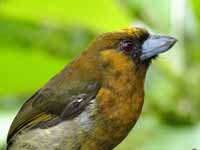
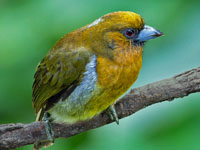

Barbet,_Toucan Semnornis ramphastinus
Description: The toucan barbet has black crown and face. It has a greyish-blue fore-neck, red breast, and black tipped bill. It is about 20 cm long and weighs 80 to 115 grams. The toucan barbet excavates a nest cavity in a tree. Helpers aid the breeding pair.
Range: Lestern Andes of Ecuador, and Columbia.
Habitat: Primary plus secondary forests and their edges.
Diet: Mainly fruit. Also insects such as termites, small reptiles, nectar, tree sap, and flower petals.
Conservation status: It is listed as Near Threatened. The population is reducing, though not vey fast, due to logging which destroys trees of nesting diamenter.
Image by: 1) Mmcnally - Ecuador 2) Jerry Oldenettel - Ecuador Nick Athanas 3, 4) EcuadorRange: Lestern Andes of Ecuador, and Columbia.
Habitat: Primary plus secondary forests and their edges.
Diet: Mainly fruit. Also insects such as termites, small reptiles, nectar, tree sap, and flower petals.
Conservation status: It is listed as Near Threatened. The population is reducing, though not vey fast, due to logging which destroys trees of nesting diamenter.
